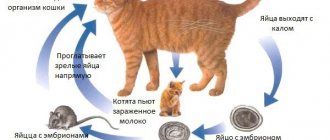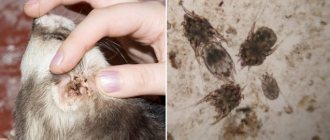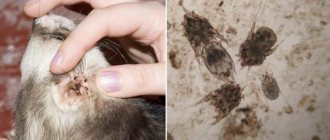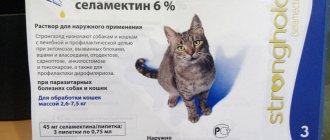Helminthiasis is a serious parasitic disease that affects not only people, but also animals. Helminth eggs hide in places that people and animals do not avoid: grass, food (especially poultry, animals and fish), soil. Even air and water can be enriched with parasite eggs. To eliminate the possibility of infection, you need to monitor not only the health of your body, but also the health of your pets. In particular, cats. It is important to be able to recognize the symptoms and know what to give your cat for worms.
Symptoms of the presence of worms
Any disease has stages of development. To prevent the disease from progressing, symptoms must be identified by observing and examining the cat. Here are several criteria that can confirm the presence of a parasitic disease:
- rare but severe cough;
- lack of appetite;
- causeless weight loss;
- bowel movement with bloody discharge;
- specimens of parasites in feces;
- bloating (inflammation in the small intestine);
- hard abdominal cavity;
- microflora disturbance;
- diarrhea (worms produce prostaglandin particles, which cause watery diarrhea).
In advanced cases, to the already mentioned symptoms, new ones are added, which have an even more significant effect on the overall health of the animal:
- insufficient bowel movements (parasites irritate the intestines and interfere with the absorption of fats and other substances, thereby forming a buildup in the colon and, as a result, constipation);
- high temperature (the body is trying to kill parasites);
- allergies (helminths can locally destroy the intestines, as a result of which food particles enter the blood and cause inflammation);
- a significant decrease in activity (due to a deficiency of nutrients in the body, which cease to be absorbed with the appearance of parasites);
- violation of the skin (a large number of worms in the body provokes the appearance of rashes, boils, ulcers, etc.);
- pale eyes;
- brightening of the oral cavity;
- muscle and joint pain (worms can migrate, in this regard, muscle tissue is injured and the immune system begins a fight, which results in inflamed muscles);
- pain in the liver (happens when helminths form a plug in the bile duct).
IMPORTANT! Worms greatly weaken cats and if left untreated, the animal can die. Death occurs due to intestinal rupture. And the rupture occurs due to blockage.
Why is helminthic infestation dangerous?
Worms in kittens injure the mucous membrane of the digestive tract. Penetrating into the internal organs, they violate the structural integrity of the tissues and cells of the animal, limiting their functional activity. Emitting toxins during vital activity and decomposition, helminths lead to severe intoxication of the pet’s body. Weakened by the fight against endoparasites, the latter becomes vulnerable to various infections and viruses. In advanced cases (if vital arteries are damaged, the intestines are blocked or ruptured), the worst thing happens - the kitten dies.
Types of worms
Helminths are divided into several types: flat, round, tapeworms and flukes. Each of them has types. There is a risk of infection for each of the varieties, but in most cases cats are susceptible to infection with eggs of roundworms and tapeworms. What you can give your cat for worms depends on the type of worms.
Wide tapeworm
The longest worms. In the human body they can reach 11 m in length. In the animal's body - 2 m. Infection occurs when eating raw fish meat. Causes stomach irritation, loss of appetite, decreased activity and weight loss (not overall weight).
Hookworm
They have the smallest eggs and can enter the animal’s body through the skin. But more often they become infected through food that already contains larvae. Hookworms live in the intestines and feed on blood. If infected, small bloody clots will be visible in the animal's stool.
Cestodes
Worms that can reach 70-80 cm in length. Their eggs are quite large and resemble grains of rice in appearance. They can be found near the animal's anus and in feces. Can damage the pulmonary system and cause a severe dry cough.
Nematodes
Outwardly, they resemble threads that are 1.5-2 cm long. Cats most often become infected with such worms by eating feces that contain parasite eggs or by contact with infected animals. If a nursing cat has worms, her kittens may receive nematode eggs through the milk.
Liver fluke
Located on the lining of the liver. The gallbladder and pancreas also suffer from the liver fluke. Throughout infection, pain in the liver becomes stable. Infection occurs through food, especially through raw meat of river fish and river water.
Ascaris
Outwardly they resemble Italian pasta, the length often does not exceed 5-5.5 cm. Ascaris causes diarrhea due to the presence of its own waste products. And if left untreated for a long time, it clogs the intestines, thereby causing constipation. It often provokes allergies because the intestinal walls lose their integrity and undigested food enters the bloodstream.
Toxocara
Roundworms reaching a length of 4-5 cm. They are located in the intestines and gall bladder. It is toxocara that causes constipation and can cause allergies and high body temperature. They can be infected by licking the genitals. For kittens, they are especially dangerous due to their size, as they can rupture the intestines.
Cucumber tapeworm
In the body of a cat, it can reach 30 cm in length. They are dangerous because they cling to the intestinal walls with their cone-shaped processes, thereby destroying the mucous membrane. Cats that have fleas are susceptible to infection. They are the ones who carry cucumber tapeworm eggs.
What parasites pose a danger to humans?
Of the ecto- and endoparasites considered, you should be wary of fleas, ixodid ticks, toxoplasma and helminths. All of them, except toxoplasma, are transmitted by contact.
You can become infected with toxoplasmosis only during the removal of feces, and the disease itself is generally mild. Complications develop only with weakened immunity, so the risk group includes pregnant women, children under 3 years of age and the elderly.
Subcutaneous parasites and lice eaters are not dangerous to humans, since their mouthparts are not adapted for gnawing through our skin. They are also not happy with their lower body temperature compared to cats. In the worst case scenario, you will end up with bites and redness. The exception is sarcoptic mange (scabies).
Hemobartonellosis is an exclusively feline disease, so it is not transmitted to people or dogs. Transmission of other blood parasites is possible only through ticks. Also, do not be afraid of coccidia.
ADVICE!
Do not let your pet lick wounds on your skin until he gets better, and treat your hands with antiseptic or regular soap after each contact.
Where can a cat become infected with worms?
Cats are at risk of becoming infected with worms from birth. Parasite eggs can enter the body through the milk of an infected mother. But there are other sources of infection that are best known about before symptoms appear. There are many options for what you can give your cat. Preventive prevention is the best way to prevent worms.
- Milk from an infected mother. Some larvae reach the size of a wheat grain, and some are completely invisible and are able to penetrate the mammary glands and the animal’s body through the skin.
- Feeding on rats and mice. Rodents have long been considered carriers of various infections, including worms.
- Presence of fleas. When an animal picks fleas in its own fur, it is susceptible to infestation by larvae through the ingestion of parasites.
- Eating meat from birds, animals and fish. Adult worms can be seen in rotten meat with the naked eye. When they enter the body, they do not die, but adapt and grow successfully, destroying the animal from the inside.
- Drinking river water. It contains not only infections, bacteria, but also eggs of parasites left over from decomposed fish, cancerous bodies and garbage.
- Contacts with infected animals. Sometimes animals lick each other's genitals, and the fur around the anus may contain traces of feces or larvae. Animals with cestodes are capable of infecting healthy cats through the air.
- Shared meals. Often, pets are fed from the same dish, without realizing that toxocara, roundworms and other types of worms can pass into a healthy body through food and water.
- Earth, sand. Outdoor animals are often fed from the ground. Throw leftover food onto the sidewalk, lawn or other areas of the ground. You can often find cats and dogs eating food abandoned by people on the beach. Earthen and sand grains may contain helminth eggs, which will successfully enter the cat’s healthy body.
Basic rules for treating a kitten for fleas
Before applying the anti-flea solution, you must carefully read the instructions and follow the recommendations indicated therein.
The method of processing depends on the form of the medicine:
- The drops should be poured from a special pipette onto the withers so that the furry patient cannot lick them off. It is forbidden to bathe the cat for three days before and after application;
- adjust the collar so that a finger fits between it and the neck;
- Distribute the shampoo evenly over the body, lather, wait 5-10 minutes. Rinse with plenty of running water and dry the fur thoroughly;
- Spread the sprays over the pile in the open air from a distance of 10-15 cm. They try not to treat cats in this way. It can be difficult to ensure that the animal does not lick itself until the substance is completely dry.
The frequency of procedures depends on the active ingredient of the drug and the pet’s lifestyle. Typically, preventative treatments are carried out every 1-3 months.
What can you give a cat for worms: top 11 drugs
Now the question definitely arises of what to give the cat for worms. After all, it is easier to prevent a disease than to treat it. It’s cheaper and there’s no damage to the animal’s health. There are many options for prevention and treatment, but it is better to focus on proven remedies. After all, time to check the effectiveness of drugs is an unaffordable luxury at a time when a furry pet is seriously ill.
- Drontal. Available in tablet form. Get rid of tape and round worms. The tablets are small in size, so they are convenient to give to the animal. Suitable for prevention in adults and kittens over 3 weeks of age. 1 tablet is designed for 4 kg of weight. The average cost of 2 tablets is 350-380 rubles.
- Milbemax. Available in tablet form. Suitable for the treatment of worms living in the gastrointestinal tract of cats. The drug is easy to use as it is added to food. Suitable for young and adult individuals. The average cost is 320-360 rubles.
- Vacation. Available in tablet form. Eliminates nematodes, cestodes, trematodes. Suitable for treatment and prevention in adults and kittens from 3 weeks. For initial and moderate degrees of infection, 1 tablet is enough to eliminate all symptoms. In case of severe infection, the 2nd tablet should be given after 1.5-2 weeks. The cost varies from 400 to 1800 rubles.
- Helmimax. Available in tablet form. Suitable for adults and kittens. Fights worms living in the intestines. With the correct dosage, it has no side effects and is easily tolerated by animals of different ages and breeds. The average cost is 340-360 rubles.
- Profender. Available in the form of drops. The drug is easy to use due to external application to the skin. Removes tapeworms, roundworms and worms that affect the pulmonary system. The average cost is 600-800 rubles (depending on the weight of the animal).
- Pirantel. Available in tablet form. The disadvantage is the size. It is not convenient to feed to cats, and the crushed drug in food repels the animal and has a bitter aftertaste. Contraindicated during pregnancy. The average price is 25-80 rubles.
- Inspector. Complex drug. Suitable for prevention. It gets rid of not only worms, but also lice, fleas, lice-eaters, etc. Available in the form of drops. The drug is divided into weight groups from 0 kg to 15. The average cost is 290-360 rubles.
- Stronghold. Available in the form of drops. Kills not only helminth eggs, but also ticks, fleas, and treats ear scabies. It does not affect formed worms, but kills their eggs in infected blood. Suitable for cats and dogs weighing 2.6-7.5 kg. The average cost is 1100-1200₽.
- Prosit. Available in the form of a sweetish suspension. Suitable for treating kittens and adults. It has a strong anthelmintic effect and is excreted from the body through feces. The average cost is 100-120 rubles.
- Trontsil. Available in tablet form. Suitable for treatment and prevention in adults and kittens. Sold with stickers for the animal's veterinary passport. The average price for 20 tablets is 340-370 rubles.
- Prazitel. Available in tablet form. Administered orally, excreted in urine and feces. Acts quickly. Suitable for treating kittens from 3 weeks and puppies from 2 weeks. Contraindicated in severely weakened animals, pregnant and lactating cats. The average price for 2 tablets is 50-80 rubles.
IMPORTANT! Before purchasing the drug, you need to consult a veterinarian. There are medications with contraindications, and in order to avoid intoxication and side effects, it is necessary to correctly determine the dosage.
Prevention
Prevention is important so that in the future questions do not arise about how to rid your pet of helminths. Basic recommendations:
- In order not to subsequently be tormented by the question of when it is necessary to urgently worm the baby, you need to carry out these activities regularly with the cat. It is recommended that the cat undergo anthelmintic therapy 10 days before mating and 3 weeks before the upcoming birth.
- From time to time you can give your pet food steamed with garlic; it helps remove helminths quite well.
- It is necessary to carefully monitor the cleanliness of the tray; it must be constantly washed and treated with disinfectant solutions.
- Outdoor clothing and shoes should be kept as far away from the kitten as possible.
- You should not pet the kitten after coming in from the street; you should wash your hands before doing so.
- Regular flea and worm treatment will help keep your pet healthy for many years.
A caring owner should pay attention to the kitten, because it is at this time that the baby’s health is established. In childhood, worms can cause significant damage to a pet's health.
What to give your cat for worms: top 3 tips for ease of use
IMPORTANT! Before starting treatment for worms, you need to get rid of other parasites (fleas, lice eaters, etc.). If this is not done, the treatment will not be effective.
Refusal of medication is a normal reaction for any animal. After all, tablets and drops do not have an attractive appearance, taste, or smell. In order for the cat to eat the drug, it is worth approaching the issue of use with cunning:
- Grind the tablet to a powder and mix it with wet food, add to porridge or other treats that have a strong odor. This is necessary in order to eliminate the smell of the medicine.
- Use an indexer (pill dispenser). Externally, the device resembles scissors. It has a rubber fastening at the end. It is thrust into the animal’s mouth, closer to the throat, and holds the mouth until swallowing. You can do it with your hands, but this increases the risk of being bitten.
- Inject water with a crushed tablet using a syringe without a needle. Hold your mouth until the cat swallows the liquid.











